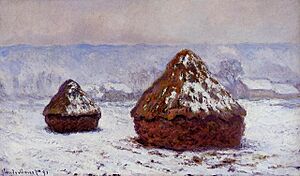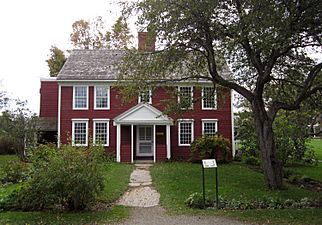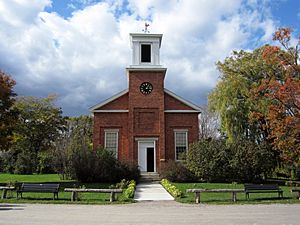Shelburne Museum facts for kids

Shelburne Museum's Round Barn
|
|
| Established | 1947 |
|---|---|
| Location | 6000 Shelburne Road Shelburne, Vermont, U.S. |
| Type | Museum of art and Americana |
| Collection size | >150,000 |
| Founder | Electra Havemeyer Webb |
The Shelburne Museum is a special place in Shelburne, Vermont, United States. It's a museum filled with amazing art, cool designs, and items that show what American life was like long ago. Imagine a huge collection of over 150,000 items! These are displayed in 39 different buildings. What's really neat is that 25 of these buildings are historic. They were carefully moved from other places to the museum grounds. The museum covers a big area of 45 acres, close to Lake Champlain.
You can see all sorts of things here. There are beautiful Impressionist paintings, unique folk art, cozy quilts, and old fabrics. You'll also find fancy decorative arts, old furniture, and American paintings. Plus, there's a huge collection of items from the 17th to the 20th centuries. Shelburne Museum is especially known for its 19th-century American folk art, quilts, and decoys. They also have many old carriages.
The museum was started in 1947 by a woman named Electra Havemeyer Webb. She was one of the first people to collect American folk art. Her parents, Henry Osborne Havemeyer and Louisine Elder Havemeyer, were famous for collecting Impressionist and Asian art. But Electra had her own ideas. She loved art, objects, and buildings that showed a unique American style.
When she created the museum, Electra had a brilliant idea. She decided to collect 18th and 19th-century buildings from New England and New York. Then, she moved 20 of these historic structures to Shelburne. This way, she could display the museum's collections inside them. These buildings include old houses, barns, a meeting house, and even a one-room schoolhouse. There's also a lighthouse, a jail, a general store, a covered bridge, and a huge 220-foot steamboat called Ticonderoga.
Electra Webb wanted the museum to be "an educational project, varied and alive." The museum's collections are set up like a small village with old New England buildings. The outdoor areas are also beautiful, with over 400 lilac bushes, a round formal garden, and gardens for herbs and old-fashioned vegetables.
In 2013, the Pizzagalli Center for Art and Education opened. This new building has two galleries, an auditorium, and a classroom. It helped the museum stay open all year round, instead of just from mid-May through October.
In 2023, the museum announced a new Native American Initiative. This project plans to build a special place to show and explain Native American items. It will include objects the museum already has and a large collection of 200 pieces from Plains, Prairie, and Southwest groups.
Contents
Museum History
The Shelburne Museum's amazing collection began with Electra Havemeyer Webb. She was a pioneer in recognizing the beauty and value of everyday items and crafts from rural America. Mrs. Webb was a passionate collector of American folk art. She officially founded the museum in 1947. Her unique idea was to move historic buildings from New England and New York to the museum grounds. This allowed her to display the collections in a truly special way.
Exploring the Collections

The heart of the Shelburne Museum's collection was built by Electra Havemeyer Webb. She was a groundbreaking collector of American folk art. Mrs. Webb often shared ideas with other important early collectors. These included Katherine Prentis Murphy, Henry and Helen Flynnt, and Henry Francis du Pont. Mr. du Pont even founded the Winterthur Museum and said Mrs. Webb inspired him to collect American decorative arts.
Since Mrs. Webb passed away in 1960, the museum's collections have continued to grow. They focus on folk art and how modern art connects to the existing collection. The many artifacts here show the amazing skill and artistic quality of objects made and used by Americans over three centuries. Visitors can see these objects in galleries and rooms set up to look like different time periods. There are also hands-on exhibits and demonstrations.
Items related to transportation, farming, and trade show how America developed industrially. These collections are very important, especially as local communities change from farming to other types of work.
The main goal of Shelburne Museum is to make people's lives richer through art, history, and culture. With about 150,000 objects, it's one of the largest and most varied collections in the United States. It's known for its wide range, high quality, and deep understanding of American creativity.
Folk Art and Circus Wonders
Shelburne's folk art collection is huge! It includes 1,400 wildfowl decoys and tiny carvings. There are also 150 trade figures and signs, 120 weathervanes, and 50 carousel figures. This includes all 40 animals from an early Dentzel carousel. The circus collection is also amazing. It has 600 old posters, letters, and items from P.T. Barnum. You can also see the hand-carved 3,500-piece Kirk Brothers Miniature Circus. The Roy Arnold Circus Parade is another highlight. It's a miniature recreation of 112 attractions from famous circuses. This display stretches for 525 feet in a special building!
Textiles and Decorative Arts
The museum's textile collection is beautiful. It has 770 bed coverings, including 500 quilts. There are also 400 hooked and sewn rugs. You can see early household textiles like 1,800 samplers, laces, and linens. Plus, there are 2,800 costumes and accessories. The decorative arts collection has 6,650 pieces. These include glass, ceramics, pewter, and metalwork. It also has one of the best collections of 18th and 19th-century painted furniture in the country.
More than 1,000 dolls, 27 dollhouses, and 1,200 doll accessories are also on display. These miniature items often look like the larger collections of ceramics and furniture in the museum. The collection of American and European toys dates back to the early 1800s.
Paintings and Fine Art
The museum has about 3,200 American prints, paintings, drawings, and graphics. These artworks show scenes from daily life. Important American paintings include works by famous artists like Bierstadt, Cassatt, Homer, and Grandma Moses.
There's also a special group of European paintings and pastels from the famous Havemeyer collection. These include works by artists like Degas and Monet. They are shown in rooms that look like the Webbs' New York apartment from around 1930. These are the only Impressionism paintings you can see in public in Vermont.
Tools and Transportation
The collections also feature 225 horse-drawn vehicles. Experts say this is one of the best collections in the nation. There are 1,000 farming tools and 5,000 hand tools. These tools show how people worked with wood, metal, leather, and fabric long ago. You can often see craftspeople at work in exhibits. They demonstrate blacksmithing, printing, spinning, and weaving. An old apothecary shop and doctor's office display 2,000 old medicines and medical tools from the early 1900s.
The museum's collections are spread across 38 exhibition buildings. As mentioned, 25 of these buildings were moved to the museum site. These include the 1871 Colchester Reef Lighthouse. There are also three historic and three replica barns, including a unique 1901 Vermont round barn. You can ride a vintage operating carousel. There are also blacksmith and wheelwright shops, and a weaving shop with a working Jacquard loom. You can see a working exhibit of late 19th-century printing equipment.
Other buildings include an 1840 one-room schoolhouse and an 1890 Vermont slate jail. There's an 1840 general store and a rare 18th-century up-and-down sawmill. A 19th-century covered bridge has two lanes and a footpath. You can also visit the reconstructed office of a famous Vermont doctor, D. C. Jarvis. There's an 1890 railroad station, a 1914 steam locomotive, and an 1890 private rail car. And don't forget the huge 1906, 220-foot steamboat Ticonderoga, which is a U.S. National Historic Landmark.
Museum Buildings
- Apothecary Shop
- Beach Lodge and Gallery
- Ben Lane Print Shop
- Blacksmith Shop
- Brick House
- Castleton Jail
- Charlotte Meeting House
- Circus Building
- Colchester Reef Lighthouse
- Covered Bridge
- Diamond Barn
- Dorset House
- Dutton House
- Electra Havemeyer Webb Memorial Building
- General Store
- Hat and Fragrance Textile Gallery
- Horseshoe Barn and Annex
- Owl Cottage Activity Center
- Pizzagalli Center for Art and Education
- Pleissner Gallery
- Prentis House
- Rail Car Grand Isle
- Rail Locomotive No. 220
- Round Barn
- Shelburne Museum Cafe
- Shelburne Railroad Station and Freight Shed
- Vergennes Schoolhouse
- Settlers' House
- Shaker Shed
- Stagecoach Inn
- Stencil House
- Stone Cottage and Smokehouse
- Ticonderoga (steamboat)
- The Toy Shop
- Variety Unit
- Vermont House
- Weaving Shop
- Webb Gallery
Images for kids
-
Covered Bridge, built in 1845
-
Dutton House, built in 1782
-
Stencil House, built c. 1804
-
Horseshoe Barn, built 1947-1949
See also










